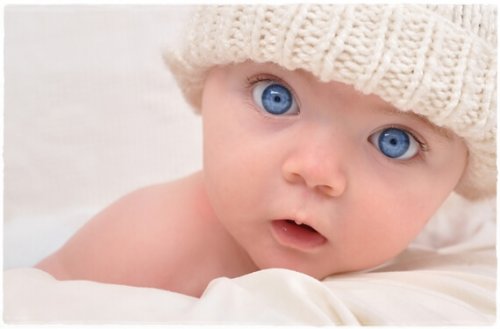What Determines Your Children's Hair and Eye Color?

In this article we’ll take a look at the factors that determine our children’s hair and eye color.
We’re all born with a set of genes passed down by our parents. These influence the color of our hair and eyes, the shape of our nose and our ears, and many other characteristics.
Every one of a newborn’s features is passed down by their parents in the genes that they themselves inherited from the child’s grandparents.
These genes will stay with the child throughout their lifetime, and one day, they’ll pass some of them on to their own sons and daughters.
There are billions of possible combinations, some more likely than others. This is what makes every child different from their brothers and sisters.
Some of these combinations are responsible for our hair and eye color.
A baby’s genetic makeup is in place from the moment of conception. The father provides half of his genetic heritage in his sperm.
Meanwhile, the mother also gives the child half of her genes, as well as a place for these first few cells to grow into a baby.
Chance determines which characteristics come from the mother’s side of the family and which come from the father.
Below, we’ll look at some of the factors that determine your child’s hair and eye color.
What does your child’s hair and eye color depend on?
Eye color
They may be blue, green, brown or black. The human eye comes in a broad and beautiful palette of colors.
However, we now know that a child’s eye color depends entirely on genetics.
By looking at the eye color of the parents, grandparents and great grandparents, it is possible to predict what color a baby’s eyes will be.
However, genetics will sometimes have a surprise in store.

In simple terms, every human being has two types of genes: dominant and recessive. Both play a role in an individual’s hair and eye color.
Dominant genes are stronger. These genes are more likely to determine the eye color of the newborn.
Recessive genes are weaker, but when they’re present on both sides, the recessive allele is expressed.
Let’s look at the example of a father with blue eyes and a mother with brown eyes.
In this case, the child would be unlikely to have blue eyes. This is because the brown color phenotype is dominant, whereas blue is recessive.
However, recessive genes are present in our DNA, even if they don’t affect our appearance. This means that characteristics such as blue eyes may skip a generation.
“Every one of a newborn’s features is passed down by their parents in the genes that they themselves inherited from the child’s grandparents”
Hair color
Just like their eye color, your child’s hair color will depend on the genes that they inherit from you and your partner.
However, it’s much more difficult to predict what color a child’s hair will be.
The color of a person’s hair is the result of the pigmentation of their hair follicles.
These little envelopes protect the roots of the hair. Depending on the type of melanin present, the follicles will produce brown, blonde, red or black hair or others.
According to current research, there are certain genes that play a role in determining hair color. For example, the allele for brown hair is dominant, while blond is recessive.
In general, darker coloring comes from dominant genes, while fair hair comes from recessive ones.

For example, if the father has brown hair and doesn’t have any fair-haired ancestors or relatives, and the mother is blonde, the baby is likely to have dark hair.
This is because, in this case, the father’s hair color is dominant while the mother’s is recessive.
The combination of two sets of DNA can give rise to an infinite number of combinations.
Thanks to scientific advancements, however, it’s now possible to predict some of your baby’s characteristics depending on the dominant and recessive genes that they’ll inherit.
In this article we’ll take a look at the factors that determine our children’s hair and eye color.
We’re all born with a set of genes passed down by our parents. These influence the color of our hair and eyes, the shape of our nose and our ears, and many other characteristics.
Every one of a newborn’s features is passed down by their parents in the genes that they themselves inherited from the child’s grandparents.
These genes will stay with the child throughout their lifetime, and one day, they’ll pass some of them on to their own sons and daughters.
There are billions of possible combinations, some more likely than others. This is what makes every child different from their brothers and sisters.
Some of these combinations are responsible for our hair and eye color.
A baby’s genetic makeup is in place from the moment of conception. The father provides half of his genetic heritage in his sperm.
Meanwhile, the mother also gives the child half of her genes, as well as a place for these first few cells to grow into a baby.
Chance determines which characteristics come from the mother’s side of the family and which come from the father.
Below, we’ll look at some of the factors that determine your child’s hair and eye color.
What does your child’s hair and eye color depend on?
Eye color
They may be blue, green, brown or black. The human eye comes in a broad and beautiful palette of colors.
However, we now know that a child’s eye color depends entirely on genetics.
By looking at the eye color of the parents, grandparents and great grandparents, it is possible to predict what color a baby’s eyes will be.
However, genetics will sometimes have a surprise in store.

In simple terms, every human being has two types of genes: dominant and recessive. Both play a role in an individual’s hair and eye color.
Dominant genes are stronger. These genes are more likely to determine the eye color of the newborn.
Recessive genes are weaker, but when they’re present on both sides, the recessive allele is expressed.
Let’s look at the example of a father with blue eyes and a mother with brown eyes.
In this case, the child would be unlikely to have blue eyes. This is because the brown color phenotype is dominant, whereas blue is recessive.
However, recessive genes are present in our DNA, even if they don’t affect our appearance. This means that characteristics such as blue eyes may skip a generation.
“Every one of a newborn’s features is passed down by their parents in the genes that they themselves inherited from the child’s grandparents”
Hair color
Just like their eye color, your child’s hair color will depend on the genes that they inherit from you and your partner.
However, it’s much more difficult to predict what color a child’s hair will be.
The color of a person’s hair is the result of the pigmentation of their hair follicles.
These little envelopes protect the roots of the hair. Depending on the type of melanin present, the follicles will produce brown, blonde, red or black hair or others.
According to current research, there are certain genes that play a role in determining hair color. For example, the allele for brown hair is dominant, while blond is recessive.
In general, darker coloring comes from dominant genes, while fair hair comes from recessive ones.

For example, if the father has brown hair and doesn’t have any fair-haired ancestors or relatives, and the mother is blonde, the baby is likely to have dark hair.
This is because, in this case, the father’s hair color is dominant while the mother’s is recessive.
The combination of two sets of DNA can give rise to an infinite number of combinations.
Thanks to scientific advancements, however, it’s now possible to predict some of your baby’s characteristics depending on the dominant and recessive genes that they’ll inherit.
This text is provided for informational purposes only and does not replace consultation with a professional. If in doubt, consult your specialist.








